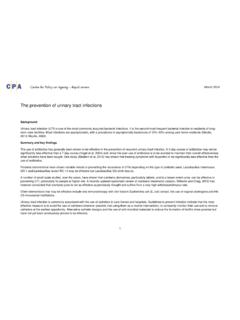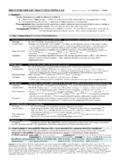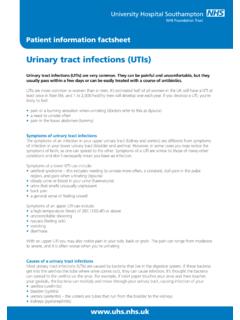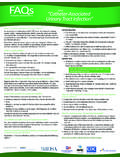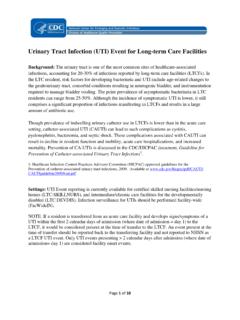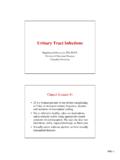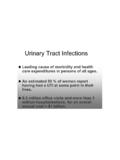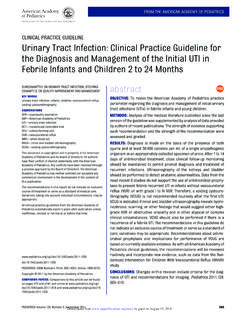Transcription of ABCs for Diagnosing Urinary Tract Infection in Long Term Care
1 At least one of the symptoms below (new or increased)Fever Costovertebral angle (CVA) pain or tendernessRigors (shaking chills)Delirium Flank pain (back, side pain)Pelvic discomfort Acute hematuriaMalaise or lethargy with no other cause * Mental status changes alone are not specific enough to identify symptomatic Urinary Tract Infection . See reverse side for alternative for Diagnosing Urinary Tract Infection in Long Term CareResident Name: Date/Time: Nurse: MD/NP/PA: Diagnosis of Urinary Tract Infection (UTI) in long term care resident requires clinical signs and symptoms ofUTI and a positive : Clinical Signs and Symptoms of UTI1 CHECK HERE IF CRITERIA ARE MET FOR SIGNS OR SYMPTOMSR esident with indwelling catheterAcute dysuria alone OR Fever + at least one of the symptoms below (new or increased) OR If no fever, at least two of the symptoms below (new or increased) Urgency FrequencySuprapubic pain Gross hematuriaCostovertebral angle (CVA) pain or tendernessUrinary incontinenceResident without indwelling catheter*Blood Pressure Pulse Temperature Respiratory Rate Fever (oral > 100 F or any site > 2 F above baseline or repeated oral > 99 F / rectal > F)Bacteria (Order urinalysis and culture & sensitivity if above criteria are met)Collect clean voided specimen if possible.
2 In and out catheter if necessary. For residents with chronic indwelling Foley catheter, change catheter; send urine obtained from new CBC, BMP if clinically indicated ( , lethargy, fever). The presence of an elevated WBC count suggests Infection , with or without a Positive NegativeLeukocyte esterase Positive Negative Pyuria > 10 WBC urinalysis Culture and sensitivityPositive urine culture:Clean catch specimen: > 105 cfu/mL with < 2 organismsCatheterized specimen (straight cath or newly placed indwelling cath): > 103 cfu/mL with > 1 organismNegative urine cultureCare PlanCriteria met for UTI symptoms AND positive urine culture Criteria not met for UTI symptoms (with or without a positive urine culture)Review for treatment with antibioticsMonitor vital signsMonitor fluid intake and increase if indicatedReview for alternate diagnosis Monitor vital signs and symptomsMonitor fluid intake and increase if indicatedRe-evaluate if above criteria for symptomatic UTI emergeAT ANY POINT, re-evaluate and review with MD/NP/PA, if symptoms progress or if the resident has any of the following.
3 Fever > F, heart rate > 100 or < 50, RR > 28/min or < 10/min, BP < 90 or > 200 systolic, oxygen saturation < 90%, finger stick glucose < 70 or > 300, unable to eat or directives for limiting treatment (especially antibiotics): NO YESM edication Allergies: NO YESThe resident is on warfarin (Coumadin) NO YESP rior to treatment consider review:Additional copies available at CID 2010;50:625-663 (IDSA guidelines CA-UTI): ID 2009;48:149-171 (IDSA guidelines LTCF): ICHE 2001;22:120-124 (Loeb criteria) CID 2005;40:643-54 (IDSA guidelines ASB); Interact Care Path Symptoms of UTIP ossible causes for mental status changes include: Constipation Pain Dehydration Medication or dose change Hypoxia infections such as pneumonia Hypo/hyperglycemia Urinary retention Environmental triggersNOTES

